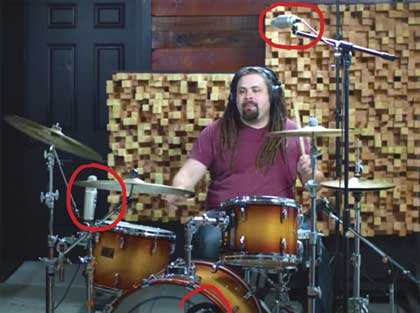Drum Miking on the Cheap
Many of us have read about the stellar, well-populated microphone cabinets of famous big studios that were used to record famous big albums. Fabulous luxury-mic manufacturers such as Neumann, Telefunken, Earthworks, and Coles get tossed around in these articles, and, yeah, you probably can’t afford their epic price tags.
Down market a bit, there are excellent and mostly affordable pre-selected mic kits for drums. We reviewed the $2,999 Earthworks DK7 in May 2021, and other offerings span from the $999 Audix DP7 to the $799 sE Electronics V Pack Club kit to Shure’s PGADRUMKIT5 for $299, and the almost-impossibly priced new Behringer BC1200 7-piece mic set for $99.
But what if you’re a GarageBand (or other free recording software user) who wants to track drums at home without spending two- to six-month’s worth of groceries? (Let’s set the Behringer kit to the side for a moment.) Well, thanks to some very affordable mics and Glyn Johns’ three-mic drum recording method, you can rock your room without shaking too many virtual bills out of your online wallet. Advertisement
Who the Heck is Glyn Johns?

Johns is a legendary recording engineer and producer. While I mourn how the word “legend” has been devalued in recent times by giving people the title who are so not legends, John recorded timeless tracks for the Beatles, the Rolling Stones, Led Zeppelin, the Who, the Eagles, Humble Pie, and others. We’ll stop there, because legend status earned. For many of these sessions, Johns deployed a three-mic technique—rather than miking every drum and plopping down room mics all over the joint—that captured mammoth sounds. This method is a very good thing for home-recording geeks, because it’s a minimalist concept that reduces setup time and keeps your microphone budget in check.
You can futz around and position the three mics wherever you feel they hear the best perspective of your kit and the room—there’s no “wrong way” if the sound is good—but here’s the basic map of Johns’ approach:
[1] Position one mic approximately four or five feet over the kit and pointing down at the snare drum.
[2] Position the second mic adjacent to the floor room and approximately six inches above its top rim. Point it towards the hi-hat.
[3] The third mic is used to record the kick drum.

Prep the Room
There’s one important caveat to the three-mic method: It works best if your recording space doesn’t sound like a plate of stewed awful. If the room is very live and you hear far too much ambience invading your drum mics, lay down carpets on those hardwood floors, close the drapes of nearby windows, and use pillows and blankets to tamp down any annoying “liveness” created by other hard surfaces (desks, tables, file cabinets, toolboxes, etc.). I’m guessing your home studio doesn’t have a fabulous recording area designed with frequency-tuned materials and bass traps, so going for a clean, dry-ish sound with impact is likely the killer app here. There’s no award for attempting to document a mammoth John-Bonham-at-Headley-Grange live sound if your room delivers a dizzying potpourri of stutter echoes, weird buzzes, and runaway reverb tails. When it comes to the recording arts, I hardly ever say “play it safe,” but in this case, playing it safe could deliver a very good drum sound. Advertisement
Oh Yeah—The Mics
Forgive me. I was having so much fun talking about Glyn Johns and mic techniques and room sounds that I forgot about the affordable-microphone focus of this piece.
For best results when you use the three-mic method, choose a matched set of large-diaphragm condenser mics for the overhead and tom mics. I’ve had great luck with Audio-Technica’s AT2020 ($99), and I did a session with a sE Electronics X1 A ($99) that turned out great, as well.
So that’s approximately $200 (not including tax) for mics one and two. Not a bad start. For the kick-drum mic—or microphone number three—go for a Shure PGA52 ($114) or a super-inexpensive Nady DM-90 ($49). You could also use any old Shure SM57 (“appropriate it” from your band’s live rig). Years ago, when I interviewed producer/engineer Brendan O’Brien about recording the Red Hot Chili Peppers’ Blood Sugar Sex Magik, he said he was in a phase where he sometimes used whatever mic his hand touched when he reached into a studio’s mic cabinet. Therefore, the kick drum mic for that classic RHCP album was a SM57.
Oh, that O’Brien move reminds me of a not-so-subtle lesson about mic placement: Don’t be afraid to experiment. Use SM57s for all three mics. Mix and match brands, models, and types (condenser, dynamic, ribbon, PZM). Play with different polar patterns (cardioid, omni-directional, figure-8, and so on). Advertisement
The only goal is to capture a drum sound that makes you smile, and, hopefully, wows your friends and other musicians. How you get there can be your secret.
Summing Up
My three mic recommendations would cost you around $314 (or $249 if you opt for the Nady)—certainly an affordable outlay for some fab mics that you can also use for recording just about anything else. You could get five mics for $299 if you picked up the Shure PGADRUMKIT5, but that package only includes dynamic microphones. We’ll try to review the new Behringer BC1200, because $99 is a truly whack price for five dynamic mics and two small-diaphragm condensers.
In any case, there’s no need to get all teary eyed and frustrated if you can’t manage a home-studio mic collection filled with Neumanns. Be confident in your ability to craft decent sounds with what you have. Use your ears and your guts, and you’ll be fine. Remember, limitations can sometimes lead to moments of creative genius. Those Beatles blokes certainly didn’t do too bad with a 4-track recorder.


